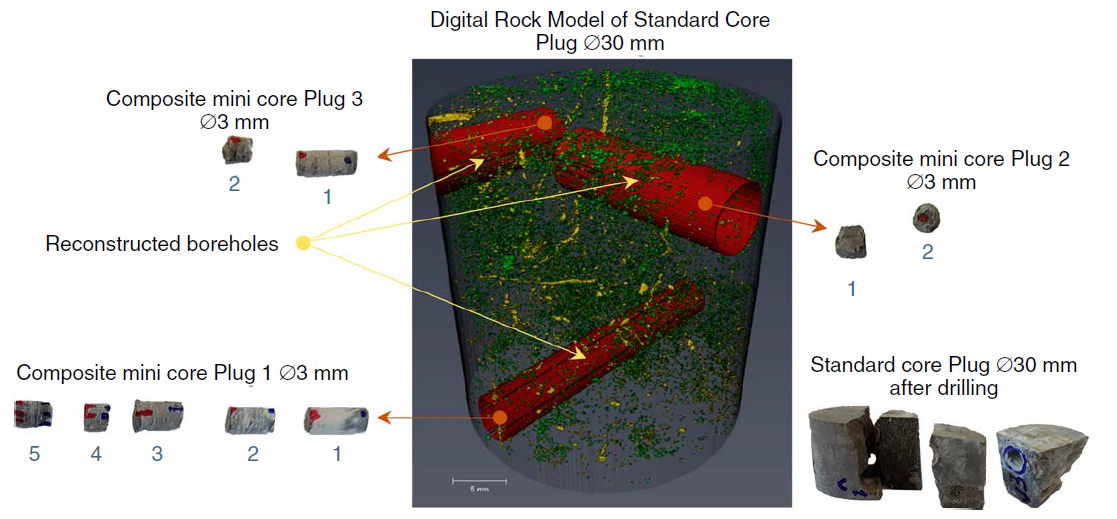Integration of Large-Area Scanning-Electron-Microscopy Imaging and Automated Mineralogy/Petrography Data for Selection of Nanoscale Pore-Space Characterization Sites
The task of reliable characterization of complex reservoirs is tightly coupled to studying their microstructure at a variety of scales, which requires a departure from traditional petrophysical approaches and delving into the world of nanoscale. A promising method of representatively retaining a large volume of a rock sample while achieving nanoscale resolution is based on multiscale digital rock technology. The smallest scale of this approach is often realized in the form of working with several 3D focused-ion-beam–scanning-electron-microscopy (FIB-SEM) models, registration of these models to a greater volume of rock sample, and estimation and scaling up of model local properties to the volume of the entire sample. However, a justified and automated selection of representative regions for building FIB-SEM models poses a big challenge to a researcher. In this work, our objective was to integrate modern SEM and mineral-mapping technologies to drive a justified decision on location of representative zones for FIB-SEM analysis of a rock sample. The procedure is based on two experimental methods. The first method is automated mapping of sample surface area with the use of backscattered electrons (BSEs) and secondary electrons (SEs); this method has resolution down to nanometers and spatial coverage up to centimeters, also referred to as large-area high-resolution SEM imaging. The second method is automated quantitative mineralogy and petrography scanning that allows covering sample’s cross section with a mineral map, with resolution down to 1 µm/pixel. Data gathered with both methods on millimeter-sized cross sections of rock samples were registered and integrated in the paradigm of joint-data interpretation, augmented with computer-based image-processing techniques, to provide a reliable classification of nanoscale and microscale features on sample cross sections. The superimposed SEM and mineral-map images were combined with physics-based selection criteria for reasonable selection of FIB-SEM candidates out of a great number of potential sites. In the result, a semiautomated work flow was developed and tested. Demonstration of the work flow is made on one of Russia’s most promising tight gas formations, where the characteristic dimension of void-space objects spans from a single nanometer to millimeters. An example of an optimized site selection for FIB-SEM operations is discussed.

The task of reliable characterization of complex reservoirs is tightly coupled to studying their microstructure at a variety of scales, which requires a departure from traditional petrophysical approaches and delving into the world of nanoscale. A promising method of representatively retaining a large volume of a rock sample while achieving nanoscale resolution is based on multiscale digital rock technology. The smallest scale of this approach is often realized in the form of working with several 3D focused-ion-beam–scanning-electron-microscopy (FIB-SEM) models, registration of these models to a greater volume of rock sample, and estimation and scaling up of model local properties to the volume of the entire sample. However, a justified and automated selection of representative regions for building FIB-SEM models poses a big challenge to a researcher. In this work, our objective was to integrate modern SEM and mineral-mapping technologies to drive a justified decision on location of representative zones for FIB-SEM analysis of a rock sample. The procedure is based on two experimental methods. The first method is automated mapping of sample surface area with the use of backscattered electrons (BSEs) and secondary electrons (SEs); this method has resolution down to nanometers and spatial coverage up to centimeters, also referred to as large-area high-resolution SEM imaging. The second method is automated quantitative mineralogy and petrography scanning that allows covering sample’s cross section with a mineral map, with resolution down to 1 µm/pixel. Data gathered with both methods on millimeter-sized cross sections of rock samples were registered and integrated in the paradigm of joint-data interpretation, augmented with computer-based image-processing techniques, to provide a reliable classification of nanoscale and microscale features on sample cross sections. The superimposed SEM and mineral-map images were combined with physics-based selection criteria for reasonable selection of FIB-SEM candidates out of a great number of potential sites. In the result, a semiautomated work flow was developed and tested. Demonstration of the work flow is made on one of Russia’s most promising tight gas formations, where the characteristic dimension of void-space objects spans from a single nanometer to millimeters. An example of an optimized site selection for FIB-SEM operations is discussed.